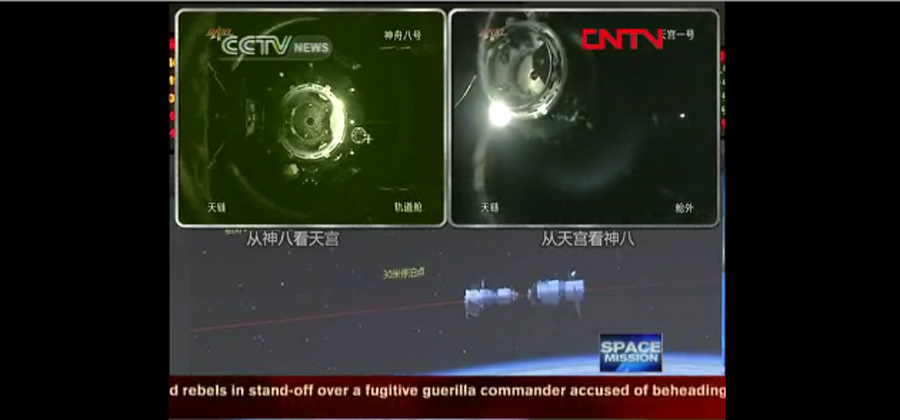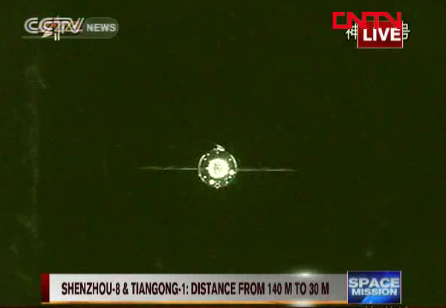China Basks in Spaceship Docking Success

After China's first-ever rendezvous of two robotic spacecraft in orbit yesterday (Nov. 2), the country is enjoying the triumph of successfully completing a key milestone in their burgeoning space program.
After a two-day journey in orbit, China's unmanned Shenzhou 8 spacecraft carefully parked itself at a prototype space lab module, called Tiangong 1, on Wednesday, to mark China's first space docking of two robotic vehicles. The accomplishment is an important step toward realizing the nation's goal of building a space station in orbit by 2020.
"The successful completion of the two spacecraft's rendezvous and docking marks that the Tiangong1/Shenzhou 8 rendezvous and docking mission has achieved a milestone success and set a sound foundation for the continued missions," Wu Ping, spokesperson for the China Manned Space Engineering Office, told reporters after the successful docking operation.
The attached spacecraft will now fly together for the next 12 days. Shenzhou 8 will then back away and dock a second time to test the technology once more. After completing this, the two spacecraft will stay together for two days before Shenzhou 8 departs for good. [Shenzhou 8: Photos From China's 1st Space Docking Flight]
Shenzhou 8 is expected to return to Earth on Nov. 17, Wu said.

In a letter to Chinese officials, Mazlan Othman, the director of the United Nations Office for Outer Space Affairs, congratulated the country after the completion of the key task, reported China's Xinhua News Agency.
"On behalf of the United Nations Office for Outer Space Affairs, I would like to extend to the People's Republic of China our congratulations on the successful docking of the unmanned Shenzhou-8 spacecraft with the Tiangong space laboratory," Othman wrote, according to Xinhua.
Get the Space.com Newsletter
Breaking space news, the latest updates on rocket launches, skywatching events and more!
Othman stated that the successful docking will help set the stage for future manned Shenzhou missions, and that she feels "encouraged by China's strong commitment to international cooperation in the peaceful exploration and use of outer space," according to Xinhua.
The successful docking of Shenzhou 8, which means "Divine Vessel" in Chinese, and Tiangong 1, which translates to "Heavenly Palace," also inspired poetry and references to folklore among commentators and members of the Chinese media.
China is aiming to launch two more missions — Shenzhou 9 and Shenzhou 10 — before the end of 2012, to help perfect the country's docking technology. Chinese officials have said that at least one of those missions will be manned.
These docking missions are key components of China's plan to construct a 66-ton space station in orbit by 2020. The lofty ambition will help China realize its goal of establishing a permanent manned presence in space.
Follow SPACE.com for the latest in space science and exploration news on Twitter @Spacedotcom and on Facebook.
Join our Space Forums to keep talking space on the latest missions, night sky and more! And if you have a news tip, correction or comment, let us know at: community@space.com.

Space.com is the premier source of space exploration, innovation and astronomy news, chronicling (and celebrating) humanity's ongoing expansion across the final frontier. Originally founded in 1999, Space.com is, and always has been, the passion of writers and editors who are space fans and also trained journalists. Our current news team consists of Editor-in-Chief Tariq Malik; Editor Hanneke Weitering, Senior Space Writer Mike Wall; Senior Writer Meghan Bartels; Senior Writer Chelsea Gohd, Senior Writer Tereza Pultarova and Staff Writer Alexander Cox, focusing on e-commerce. Senior Producer Steve Spaleta oversees our space videos, with Diana Whitcroft as our Social Media Editor.









